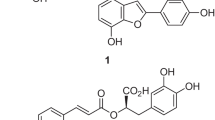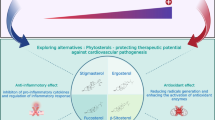Abstract
Vascular smooth muscle cells (VSMCs) are one of the sources of foam cells in atherosclerosis. However, the mechanism of VSMC-derived foam cell formation remain largely unknown. Bisdemethoxycurcumin (BDMC) is considered to possess diverse pharmacological properties, including anti-inflammation and anti-oxidation. However, the effects of BDMC on atherosclerosis remain unclear. Here, we established an in vitro foam cell model by culturing VSMCs with oxidized low-density lipoprotein (ox-LDL). The results show that BDMC reduced lipid droplets in ox-LDL-stimulated VSMCs. In addition, BDMC promotes autophagy by suppressing PDK1/Akt/mTOR signaling pathway. In vivo, BDMC alleviates inflammatory responses and lipid accumulation in in apoe−/− mice. Above all, the results from the present study suggested that BDMC may be used as a therapeutic agent for the prevention and treatment of atherosclerosis.





Similar content being viewed by others
Data availability
All data generated or analyzed during this study are included in this published article.
References
Allahverdian S, Chehroudi AC, McManus BM et al (2014) Contribution of intimal smooth muscle cells to cholesterol accumulation and macrophage-like cells in human atherosclerosis. Circulation 129(15):1551–1559
Bengmark S, Mesa MD, Gil A (2009) Plant-derived health: the effects of turmeric and curcuminoids. Nutricion hospitalaria 24(3):273–81
Bennett MR, Sinha S, Owens GK (2016) Vascular smooth muscle cells in atherosclerosis. Circ Res 118(4):692–702
Cicero AFG, Kuwabara M, Johnson R et al (2018) LDL-oxidation, serum uric acid, kidney function and pulse-wave velocity: Data from the Brisighella Heart Study cohort. Int J Cardiol 15(261):204–208
Cicero AFG, Fogacci F, Giovannini M et al (2019) Interaction between low-density lipoprotein-cholesterolaemia, serum uric level and incident hypertension: data from the Brisighella Heart Study. J Hypertens 37(4):728–731
Dutzmann S, Schiborr C, Kocher A et al (2016) Intratumoral concentrations and effects of orally administered micellar curcuminoids in glioblastoma patients. Nutrition and Cancer 68(6):943–8
Gagliardi S, Truffi M, Tinelli V, et al. 2022 Bisdemethoxycurcumin (BDC)-Loaded H-Ferritin-Nanocages Mediate the Regulation of Inflammation in Alzheimer's Disease Patients. Int J Mol Sci 23(16).
Grootaert MO, da Costa Martins PA, Bitsch N et al (2015) Defective autophagy in vascular smooth muscle cells accelerates senescence and promotes neointima formation and atherogenesis. Autophagy 11(11):2014–2032
Herrington W, Lacey B, Sherliker P et al (2016) Epidemiology of Atherosclerosis and the Potential to Reduce the Global Burden of Atherothrombotic Disease. Circ Res 118(4):535–546
Hsiao YT, Kuo CL, Lin JJ, et al. (2018) Curcuminoids combined with gefitinib mediated apoptosis and autophagy of human oral cancer SAS cells in vitro and reduced tumor of SAS cell xenograft mice in vivo. Environmental toxicology
Joy T, Hegele RA (2008) Is raising HDL a futile strategy for atheroprotection? Nat Rev Drug Discovery 7(2):143–155
Khatana C, Saini NK, Chakrabarti S et al (2020) Mechanistic Insights into the Oxidized Low-Density Lipoprotein-Induced Atherosclerosis. Oxid Med Cell Longev 2020:5245308
Kim GR, Cho SN, Kim HS et al (2016) Histone deacetylase and GATA-binding factor 6 regulate arterial remodeling in angiotensin II-induced hypertension. J Hypertens 34(11):2206–2219
Klionsky DJ (2007) Autophagy: from phenomenology to molecular understanding in less than a decade. Nat Rev Mol Cell Biol 8(11):931–937
Komatsu K, Sasaki Y, Tanaka K et al (2008) Morphological, genetic, and chemical polymorphism of Curcuma kwangsiensis. J Nat Med 62(4):413–422
Kong R, Kang OH, Seo YS et al (2018) MAPKs and NFkappaB pathway inhibitory effect of bisdemethoxycurcumin on phorbol12myristate13acetate and A23187induced inflammation in human mast cells. Mol Med Rep 17(1):630–635
Kumar S, Nanduri R, Bhagyaraj E et al (2021) Vitamin D3-VDR-PTPN6 axis mediated autophagy contributes to the inhibition of macrophage foam cell formation. Autophagy 17(9):2273–2289
Libby P, Bornfeldt KE, Tall AR (2016) Atherosclerosis: Successes, surprises, and future challenges. Circ Res 118(4):531–534
Liu K, Czaja MJ (2013) Regulation of lipid stores and metabolism by lipophagy. Cell Death Differ 20(1):3–11
Liu Q, Wang YM, Gu HF (2020) Lipophagy in atherosclerosis. Clinica Chimica Acta 511:208–214
Ouimet M, Marcel YL (2012) Regulation of lipid droplet cholesterol efflux from macrophage foam cells. Arterioscler Thromb Vasc Biol 32(3):575–581
Ouimet M, Franklin V, Mak E et al (2011) Autophagy regulates cholesterol efflux from macrophage foam cells via lysosomal acid lipase. Cell Metab 13(6):655–667
Qin L, Wang Z, Tao L et al (2010) ER stress negatively regulates AKT/TSC/mTOR pathway to enhance autophagy. Autophagy 6(2):239–247
Ringman JM, Frautschy SA, Cole GM et al (2005) A potential role of the curry spice curcumin in Alzheimer’s disease. Curr Alzheimer Res 2(2):131–136
Shi Y, Jiang S, Zhao T et al (2020) Celastrol suppresses lipid accumulation through LXRalpha/ABCA1 signaling pathway and autophagy in vascular smooth muscle cells. Biochem Biophys Res Commun 532(3):466–474
Singh A, Srinivasan AK, Chakrapani LN et al (2019) LOX-1, the Common Therapeutic Target in Hypercholesterolemia: A New Perspective of Antiatherosclerotic Action of Aegeline. Oxid Med Cell Longev 2019:8285730
Song Z, Guo Y, Zhou M et al (2014) The PI3K/p-Akt signaling pathway participates in calcitriol ameliorating podocyte injury in DN rats. Metabolism 63(10):1324–33
Thomes PG, Rasineni K, Yang L et al (2019) Ethanol withdrawal mitigates fatty liver by normalizing lipid catabolism. Am J Physiol Gastrointest Liver Physiol 316(4):G509–G518
Wang L, Jiang Y, Song X et al (2016) Pdcd4 deficiency enhances macrophage lipoautophagy and attenuates foam cell formation and atherosclerosis in mice. Cell Death Dis 21(7):e2055
Ward NC, Watts GF, Eckel RH (2019) Statin Toxicity. Circ Res 124(2):328–350
Wirka RC, Wagh D, Paik DT et al (2019) Atheroprotective roles of smooth muscle cell phenotypic modulation and the TCF21 disease gene as revealed by single-cell analysis. Nat Med 25(8):1280–1289
Xiang M, Jiang HG, Shu Y et al (2020) Bisdemethoxycurcumin Enhances the Sensitivity of Non-small Cell Lung Cancer Cells to Icotinib via Dual Induction of Autophagy and Apoptosis. Int J Biol Sci 16(9):1536–1550
Yeh CC, Su YH, Lin YJ et al (2015) Evaluation of the protective effects of curcuminoid (curcumin and bisdemethoxycurcumin)-loaded liposomes against bone turnover in a cell-based model of osteoarthritis. Drug Des Dev Ther 9:2285–2300
Zachari M, Ganley IG (2017) The mammalian ULK1 complex and autophagy initiation. Essays Biochem 61(6):585–596
Zhang J, Yang Y, Han H, et al. 2021 Bisdemethoxycurcumin attenuates lipopolysaccharide-induced intestinal damage through improving barrier integrity, suppressing inflammation, and modulating gut microbiota in broilers. J Animal Sci 99(11)
Zhang X, Zhong S (2020) PDK1 Inhibitor GSK-470 Exhibits Potent Anticancer Activity in a Pheochromocytoma PC12 Cell Tumor Model via Akt/mTOR Pathway. Anticancer Agents Med Chem 20(7):828–833
Zhou Y, Miles JR, Tavori H et al (2019) PMP22 Regulates Cholesterol Trafficking and ABCA1-Mediated Cholesterol Efflux. J Neurosci 39(27):5404–5418
Acknowledgements
Not applicable.
Funding
This work has been supported by Regional Science Foundation of the National Natural Science Foundation of China (No.81960091).
Author information
Authors and Affiliations
Contributions
XQ conceived the idea of this article and supervised the research. JZ and SG performed the research, analyzed the data and wrote the manuscript. All authors have read and approved the final version of the manuscript. The authors declare that all data were generated in-house and that no paper mill was used.
Corresponding author
Ethics declarations
Competing interests
The authors declare no competing interests.
Ethics approval and consent to participate
All animal experimental procedures in this study were conducted following the guidelines of Animal Care and Ethics Committee of Guangxi Medical University (approval no. SYXKGUI 2021–0015).
Consent for publication
Not applicable.
Additional information
Publisher's note
Springer Nature remains neutral with regard to jurisdictional claims in published maps and institutional affiliations.
Rights and permissions
Springer Nature or its licensor (e.g. a society or other partner) holds exclusive rights to this article under a publishing agreement with the author(s) or other rightsholder(s); author self-archiving of the accepted manuscript version of this article is solely governed by the terms of such publishing agreement and applicable law.
About this article
Cite this article
Zuo, J., Guo, S. & Qin, X. Bisdemethoxycurcumin suppresses the progression of atherosclerosis and VSMC-derived foam cell formation by promoting lipophagy. Naunyn-Schmiedeberg's Arch Pharmacol 396, 3659–3670 (2023). https://doi.org/10.1007/s00210-023-02558-7
Received:
Accepted:
Published:
Issue Date:
DOI: https://doi.org/10.1007/s00210-023-02558-7




